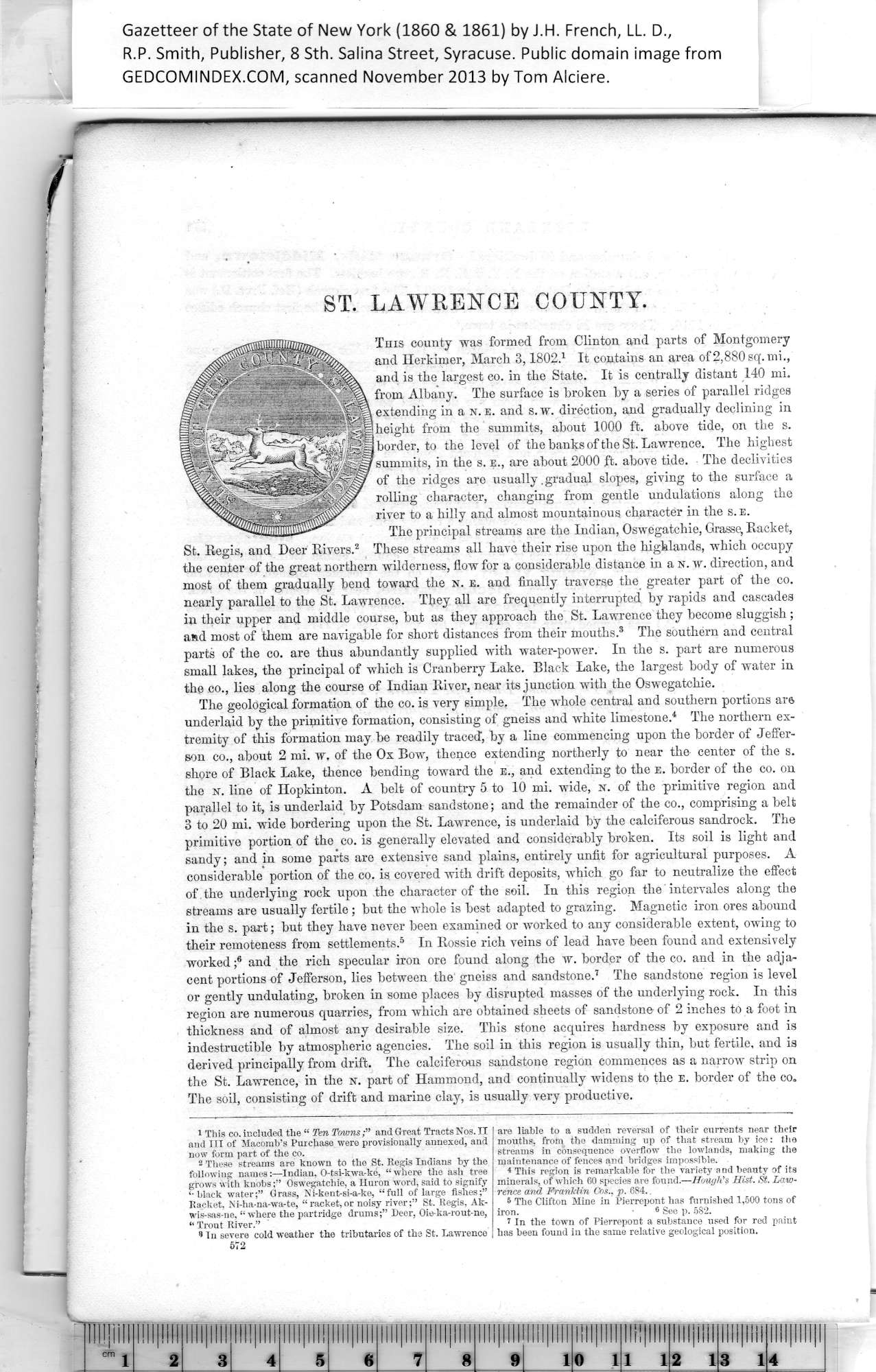|
ST. LAWRENCE COUNTY.
This county was formed from Clinton and parts of Montgomery
and Herkimer, March 3,1802.1 It contains an area of2,880sq.mi.,
and is the largest co. in the State. It is centrally distant 140 mi.
from Albany. The surface is broken by a series of parallel ridges
extending in a n. e. and s. w. direction, and gradually declining in
height from the summits, about 1000 ft. above tide, on the s.
border, to the level of the banks of the St. Lawrence. The highest
summits, in the s. e., are about 2000 ft. above tide. The declivities
of the ridges are usually, gradual slopes, giving to the surface a
rolling character, changing from gentle undulations along the
river to a hilly and almost mountainous character in the s. e.
The principal streams are the Indian, Oswegatchie, Grasse, Racket,
St. Regis, and Deer Rivers.2 These streams all have their rise upon the highlands, which occupy
the center of the great northern wilderness, flow for a considerable distance in a n. w. direction, and
most of them gradually bend toward the n. e. and finally traverse the greater part of the co.
nearly parallel to the St. Lawrence. They all are frequently interrupted by rapids and cascades
in their upper and middle course, but as they approach the St. Lawrence they become sluggish;
and most of them are navigable for short distances from their mouths.3 The southern and central
parts of the co. are thus abundantly supplied with water-power. In the s. part are numerous
small lakes, the principal of which is Cranberry Lake. Black Lake, the largest body of water in
the co., lies along the course of Indian River, near its junction with the Oswegatchie.
The geological formation of the co. is very simple. The -whole central and southern portions are
underlaid by the primitive formation, consisting of gneiss and white limestone.4 The northern ex¬
tremity of this formation may be readily traced, by a line commencing upon the border of Jeffer¬
son co., about 2 mi. w, of the Ox Bow, thence extending northerly to near the center of the s.
shore of Black Lake, thence bending toward the e., and extending to the e. border of the co. on
the n. line of Hopkinton. A belt of country 5 to 10 mi. wide, sr. of the primitive region and
parallel to it, is underlaid by Potsdam sandstone; and the remainder of the co., comprising a belt
3 to 20 mi. wide bordering upon the St. Lawrence, is underlaid by the calciferous sandrock. The
primitive portion of the co. is generally elevated and considerably broken. Its soil is light and
sandy; and in some parts are extensive sand plains, entirely unfit for agricultural purposes. A
considerable portion of the co. is covered with drift deposits, which go far to neutralize the effect
of the underlying rock upon the character of the soil. In this region the intervales along the
streams are usually fertile; but the whole is best adapted to grazing. Magnetic iron ores abound
in the s. part; but they have never been examined or worked to any considerable extent, owing to
their remoteness from settlements.5 In Rossie rich veins of lead have been found and extensively
worked;3 and the rich specular iron ore found along the w. border of the co. and in the adja¬
cent portions of Jefferson, lies between the gneiss and sandstone.7 The sandstone region is level
or gently undulating, broken in some places by disrupted masses of the underlying rock. In this
region are numerous quarries, from which are obtained sheets of sandstone of 2 inches to a foot in
thickness and of almost any desirable size. This stone acquires hardness by exposure and is
indestructible by atmospheric agencies. The soil in this region is usually thin, but fertile, and is
derived principally from drift. The calciferous sandstone region commences as a narrow strip on
the St. Lawrence, in the n. part of Hammond, and continually widens to the e. border of the co.
The soil, consisting of drift and marine clay, is usually very productive.
|
are liable to a sudden reversal of their currents near their
mouths, from the damming up of that stream by ice: the
streams in consequence overflow the lowlands, making the
maintenance of fences and bridges impossible.
4 This region is remarkable for the variety and beauty of its
minerals, of which 60 species are found.—Hough’s Hist. St. Law¬
rence and Franklin Cos.. p. 684.,
6 The Clifton Mine in Pierrepont has furnished 1,500 tons of
iron. ■ 6 See p. 582.
7 In the town of Pierrepont a substance used for red paint
has been found in the same relative geological position. |
1
This co. included the “ Ten Towns;” and Great Tracts Nos. II
and III of Macomb’s Purchase were provisionally annexed, and
now form part of the co.
2
These streams are known to the St. Regis Indians hy the
3
“ Trout River.”
|
